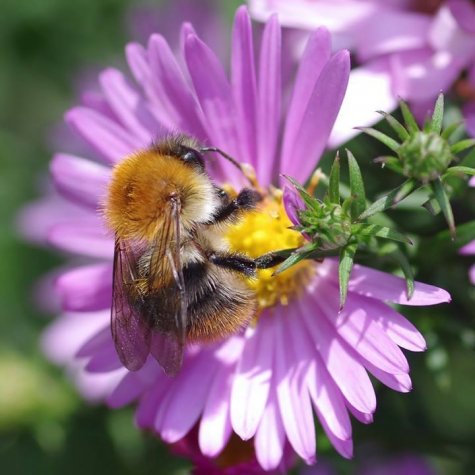Bumblebees preparing for winter
Text Meelis Uustal
Photo Inga Ilves
Translation: Liis
Common carder bee
When you happen to stroll in the garden in the noon-day sunshine it is worthwhile to check the flowering plants that the frosts has not killed yet. If nowhere else then on the flowers of the garden stonecrop (Sedum spectabile) you may still see the last bumblebees. The life cycle of bumblebees is coming to an end for this time and the young female bumblebees greedily sucking nectar on the flowers will soon creep in hiding in their winter quarters.
Young newly hatched female and male bumblebees could be seen already from mid-summer onwards. After mating, the young fertilized female bumblebees dig themselves into the soil, whereas the male bumblebees, workers and the old female bumblebees are doomed to die. They are not meant to survive the winter.
Quite as all bumblebee colonies do not develop at the same rate, all female bumblebees will not go into winter quarters at the same time. Already in August-September, the number of bumblebee species and individual could be seen to begin to decrease gradually although there was plenty of bees on the nectar plants. Most bumblebee species nest only once in the short summer of our latitudes. Thus only white-tailed bumblebees (Bombus lucorum)and more rarely a common (or brown-banded) carder bee (Bombus pascuorum) or cuckoo bumblebee hummed around the flowers of September.
But still even today sturdy and brightly-coloured bumblebees can be seen flying from flower to flower, notable by their swiftness and purposefulness, but most of all by the large pollen balls on the legs. Pollen is not collected for oneself but for the use of the larvae developing in the nest. Is this pollen-carrying bumblebee a tiny part of a several hundred-membered giant nest or do we have instead an extremely risky second nesting? Neither one nor the other is impossible, and we will not know unless we find such a nest. If weather is favourable a second nesting during the summer is not rare south of us – why not here too then.
The young female bumblebees dig themselves into soft, loose soil for winter, not particularly deep down. The winter quarters must be skilfully chosen. Not too low or moist spots, to avoid drowning, and a not too warm spot to avoid being waken up by the first springtime sun rays. The body of bumblebees will manage degrees of cold quite well –glucose is secreted into the blood (haemolymph) which prevents formation of ice crystals and damage to cells.
But while the degrees of warmth still prevail in daytime the last bumblebees can still be seen flying around.
Let us enjoy their humming on beautiful autumn days!









